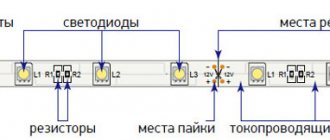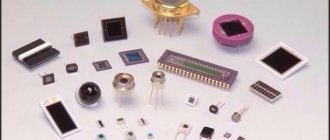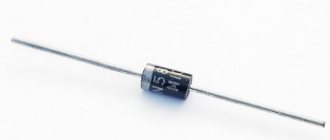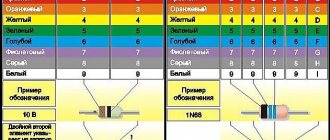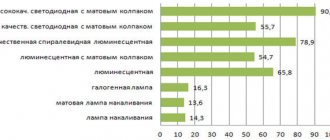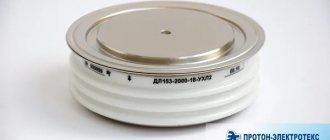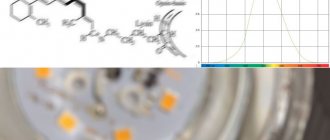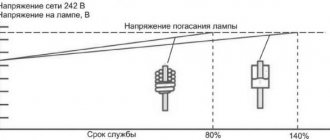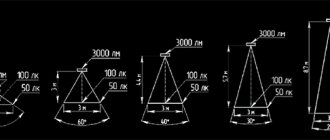The most common SMD type LEDs currently are LED SMD 5050. Despite the fact that their invasion around the world began quite a long time ago and more efficient diodes have already appeared, 5050 remains the most popular in the solid-state lighting market. This type of diodes began its “march” after SMD 3528. Compared to them, 5050 have a stronger glow (luminous flux). After their appearance, manufacturers rushed to widely use them in local lighting lamps, fortunately, due to their size, they easily (in large quantities) fit into the size of an ordinary lamp. Further use is LED strips.
If you look at today’s market, SMD 5050 ICE is mostly already used only in diode strips. Cheap and high-quality tapes can be bought here. General lighting lamps fade into the background with them (more often you can see decorative light bulbs on the counter). This is understandable; now the most effective lamps are 5630 and 5730 SMD, as well as COB. But still, diodes are needed to repair 5050 lamps. You can buy them here.
However, not everything is so “successful” here either. After all, filaments are already on their tail with leaps and bounds. Which have less heating compared to SMD, and therefore a longer service life due to little degradation of the crystals. We have a separate article on filament lamps and the filaments themselves, which you can read using our new “live” search. It’s better to check for yourself what it is. Well, this is a lyrical digression. And we will return directly to the discussion of the characteristics of SMD 5050 LEDs.
—> —>
For those who don’t really want to delve into all the characteristics of this type of diode, I will provide a summary table in which I will show the most “demanded” and necessary data. And in general, having received an assignment from the commanders of this site to write a number of articles with the characteristics of the most popular LEDs, I will adhere to the following plan: all articles will have a small descriptive part, basic brief characteristics and a complete Datasheet SMD 5050 (and other diodes) translated into Russian. So, let's get down to a brief description of the basic data.
Main characteristics of LED SMD 5050
SMD 5050 were developed for use in a variety of light sources. The main advantages, as practice has shown, are: long service life, stability of characteristics and high-quality performance. Practically not subject to vibration or temperature changes. The crystals are not affected by moisture and are designed for automatic installation. Although manual installation is quite possible with some skill. Main applications include general purpose luminaires, indicator devices, decorative lamps, automobiles and road signs. The 5050 consists of three crystals of equal power. They are produced in both single-color (white) and colored versions. We will consider both characteristics.
| Characteristics of SMD 5050 diode white | Values |
| Luminous flux, Lm | 18 |
| Power dissipation PD, W | 70 mW*3 |
| Operating temperature, Topr °C | — 40/+65 |
| Forward voltage, V | 3.3 |
| Maximum operating current, mA | 60 |
| Characteristics of SMD 5050 diode other colors | Values |
| Luminous flux, Lm (depending on color) | 12-18 |
| Power dissipation PD, W (depending on color) | 40-80 mW*3 |
| Operating temperature, Topr °C | — 40/+65 |
| Forward voltage, V (depending on color) | 2,0-3.3 |
| Maximum operating current, mA | 60 |
I can understand that now many people will have a question about the color LED SMD 5050 characteristics. Especially in those positions where it is indicated that they depend on color. Once again, this is general information for your information. You can read more accurate and detailed information below.
The features of this type of diode include the following:
- Low luminous flux degradation (less than 4% over 3000 hours of operation)
- The case is made from heat-resistant polymer that can withstand long-term temperature “load” up to 250 degrees Celsius
- The maximum temperature of the crystal at which it will not lose its properties too quickly is no more than 110 degrees
In principle, three main characteristics are enough for the common man - maximum operating current, luminous flux, voltage and power. Hmm... It turns out there are not three, but four characteristics. These are the ones you should pay attention to when choosing any LEDs if you are just starting your knowledge in the world of LED lighting. For a more detailed and in-depth study, it’s still worth turning to the full characteristics and dependence graphs of the SMD 5050. As for me, when choosing and selecting diodes, I mainly use only voltage, power and luminous flux. I study the rest using dependency graphs. It's easier for me. Yes, and it’s clearer. Figures, tables and descriptions are compiled by people, and therefore errors and typos are not uncommon. I know it from myself.
How to choose
To make the right choice, you need to consider the following:
- presence of a QR code or barcode on the packaging;
- presence of characteristics;
- The kit must contain a passport and instructions for use;
- correct spelling of the name;
- the packaging must not be damaged.
LED SMD 5050 (original)
The seller should not refuse to return it if the diodes turn out to be non-working or do not suit the buyer. In addition, the product comes with a 1-year warranty if it is original.
How to connect correctly
Before purchasing SMD 5050 LEDs, you should figure out how to connect them correctly. First of all, the load characteristics of the diodes should be taken into account. You can connect to the network only if you have a resistor . It must be remembered that the resistance of the resistors should not be less than the nominal value. The quality of each element and its service life depend on this.
Connection diagram
To understand the connection diagram and be able to work according to it, you need to have the skills of an electrician. If a person is working with LEDs for the first time, the likelihood of connecting the elements correctly is very low.
LED connection diagram
If you have to do the connection yourself, you should study the instructions as best as possible and practice on other LEDs. The common current limiter-LED combination is used here. This circuit is suitable for all single-crystal designs, the only difference is in the ratings of the current-limiting element.
An exception is possible in the case of three crystals installed on an LED matrix. In the 5050 series, it has three cathodes and anodes. The connection is made for each of them separately.
Original Datasheet LED SMD LED 5050
Main technical characteristics of LED SMD 5050 white and other colors
| Parameter | White SMD 5050 | Multi-colored SMD 5050 |
| Forward current,IF, mA | 20 *3 | 20 *3 |
| Pulse forward current, IFp, mA | 100*3 | 100*3 |
| Power dissipation,PD,W | 70 mW*3 | 40-80 mW*3 |
| Transition temperature, Tj, °C | 110 | 110 |
| Operating temperature, Topr, °C | -40/+65 | -40/+65 |
| Storage temperature, Tstg, °C | -55/+100 | -55/+100 |
| Soldering temperature, Tsld, °C | 300 | 300 |
The maximum soldering temperature is indicated when heating for no more than 2 seconds
Main conclusions
SMD 5050 LEDs have high performance and technical parameters. They are used in most lighting devices; LED strips and other devices are made based on 5050 elements. The advantages of these components are:
- technical characteristics demonstrate high efficiency and increased capabilities;
- a set of parameters allows the use of SMD 5050 in medium and high power luminaires;
- the service life of these devices significantly exceeds the performance of all alternative light sources;
- The amount of electricity consumed allows SMD 5050 to be combined into chains of 3 elements, which reduces consumption and does not create excessive problems if one crystal fails.
Let's consider ways to connect medium-power ice diodes to the most popular ratings of 5V, 12 volts, 220V. Then they can be used in the manufacture of color and music devices, signal level indicators, smooth switching on and off. I’ve been planning to make a smooth artificial dawn for a long time in order to maintain my daily routine. In addition, dawn emulation allows you to wake up much better and easier.
Read about connecting LEDs to 12 and 220V in the previous article; all methods are discussed, from complex to simple, from expensive to cheap.
- 1. Types of circuits
- 2. Designation on the diagram
- 3. Connecting the LED to a 220V network, diagram
- 4. Connection to DC voltage
- 5. The simplest low voltage driver
- 6. Drivers with power supply from 5V to 30V
- 7. Turn on 1 diode
- 8. Parallel connection
- 9. Serial connection
- 10. RGB LED connection
- 11. Turning on COB diodes
- 12. Connecting SMD5050 for 3 crystals
- 13. LED strip 12V SMD5630
- 14. LED strip RGB 12V SMD5050
Optoelectronic characteristics of SMD 5050
| Parameter | Min. | Type | Max | |
| Voltage drop, VF, V, at 60 mA | 3,2 | 3,3 | 3,4 | |
| 3,1 | 3,3 | 3,6 | ||
| 3,1 | 3,3 | 3,5 | ||
| 1,8 | 2,0 | 2,2 | ||
| 1,9 | 2,0 | 2,2 | ||
| Electrostatic discharge resistance, ESD, V | All colors | 1000 | ||
| Half brightness angle, degrees | All colors | 120 | ||
| Thermal resistance of the junction, Rth, °C/W | All colors | 6 | ||
| Power dissipation, PD, mW | 70*3 | |||
| 70*3 | ||||
| 70*3 | ||||
| 40*3 | ||||
| 50*3 | ||||
| Wavelength, nM | 465-470 | |||
| 525-530 | ||||
| 625-630 | ||||
| 590-595 | ||||
| Brightness,Iv,mCD | 900 | |||
| 3500 | ||||
| 1500 | ||||
| 1500 | ||||
As for the color temperature of white SMD 5050, crystals at 60 mA can produce the following shades:
Warm white: 3000 – 4000 K (CRI80)
Neutral white: 4300 – 4800 K (CRI80)
Pure white: 5000 – 5800 K (CRI75)
Cool white: 6000 – 7500 K (75)
By the way, I forgot a very important detail. The luminous flux in the table for white diodes is indicated for a color temperature of 5500K. For other colors, the following correction applies: in the range from 3000-4800K the luminous flux decreases by 10 percent, but in the range from 6000-7000K it increases by 10 percent. For colored crystals, the table contains data without corrections. Based on this, it is worth choosing LEDs based on brightness. Please note here that these characteristics “take place” only on high-quality diodes. In the Chinese market, I currently know of only three sellers (with whom I work closely) who offer to buy SMD 5050 with the characteristics closest to the “famous, real ones”. The difference in performance characteristics is no more than 4 percent. The most adequate and most efficient is HERE. Let's just say that you can order, but the price is also not the cheapest. You can find cheaper ones too. But here I can assure everyone that the diodes will not have the declared characteristics. Good things can't be cheap. Verified.
Real power of Chinese LEDs
90% of Chinese products, for example on the Aliexpress bazaar, are made with low-power diodes, which are much weaker than branded ones. Branded ones are produced by Samsung, LG, Philips and others. The Chinese actively use this, specifying parameters as if Samsung were installed there. After the purchase, it turns out that the brightness and power are 3-4 times lower than what the seller promised.
To learn how to distinguish good from bad crystal size by external signs, read the article “Characteristics of LEDs.”
| Chinese 5630, 5730 type No. 1 | Chinese 5630, 5730 type No. 2 | Chinese 5050 | |
| Power | 0.09W | 0.15W | 0.1W |
| Brightness | 7 lm | 12 lm | 8 lumens |
It turns out that the Chinese 5630 (5730) is 0.15W weaker than the branded 5050 by 0.2W. Be careful when choosing a product.
Main characteristics of SMD 5630
SMD 5630 on LED strip
If your knowledge of English is poor, or you are not interested in all its intimate details, then I will write a short table of its main parameters, which will be enough for you to understand the 5630 LED strip or lamp.
Technical specifications are given for the popular neutral white light diode produced by Samsung for 2011
| Parameter | 5630 |
| Nominal luminous flux, Lumen | 40 -50 |
| Power | 0.5 W |
| Operating temperature, degrees | up to + 85 |
| Rated current, mA | 150 |
| Supply voltage, current 700 mA | 3.3 volts |
| Length and width, mm | 5.6 x 3 |
| Angle of illumination, degrees | 120 |
| Color rendering index | from 80 to 90 Ra |
SMD 5630 LEDs, like SMD 5730, are produced by many companies, such as Samsung, Philips, Epistar and many companies from China. Famous manufacturers comply with all technical requirements and the parameters practically do not differ from each other. But Chinese factories have diodes of very poor quality, usually at an appropriate price.
Or they install a crystal of obviously lower power into an SMD 5630 package. The Chinese diode is characterized by short-lived operation in nominal mode, so it is usually turned on at 35% power. That's why Chinese light bulbs have so many LEDs, but the luminous flux is small. Only in this mode will he be able to work out the 20,000 hours allotted to him.
One of my corn lamps with 5630 diodes worked continuously for just over 2 years, that is, 20,000 hours. Tests showed that during this time, Chinese LEDs degraded by 30% of their original brightness.
Graphs of the main characteristics of SMD 5050 white
Graphs of optical-electronic characteristics of white SMD 5050
1 of 7
Luminous flux distribution diagram
Permissible current from the environment
Dependence of luminous flux on ambient temperature
Dependence of luminous flux on current
Current versus voltage
Change in luminous flux from clock to clock
Spectral composition of SMD 5050 radiation
What are the types?
- The first among super-bright LED lamps is SMD 3528. They have 1 meter fewer diodes. The brightness level is many times lower - SMD 3528 with 30 diodes per meter is 120 Lm, and SMD 5050 is 400 Lm.
- Also, the power of the RGB strip 5050 exceeds the parameters of its previous version SMD 3528 (0.1 W).
- Improved models SMD 5730 has a higher quality luminous flux (55 lm/W). The power of one diode is 0.5 W.
Main characteristics of RGB SMD 5050 LED
I thought I was finishing the article, but then I remembered... But I didn’t write about RGB diodes. I urgently had to open the Datasheet and hastily translate it. In principle, there is nothing complicated in these chips. Everything is outrageously simple.
In terms of application, little changes either. It is most preferable to use diodes in general-purpose lamps, indicator devices, decorative lamps, and cars.
| Characteristics of the SMD 5050 RGB diode | Red | Green/Blue |
| Power dissipation PD, W | 80 | 100 |
| Operating temperature, Topr °C | — 40/+95 | — 40/+95 |
| Forward voltage, V | 1,6-2,0 | 2,8-3.2 |
| Maximum operating current, mA | 30 | 30 |
Program for decoding SMD parts
Thanks to special programs for technicians and professionals, it is easier to determine what kind of part is in front of a specialist. The application deciphers the marking elements present on the case. After clicking the check button, it is easy to get a brief explanation of the main characteristics. Some solutions support searching for information on additional sites.
- First, enter the SMD code from the packaging.
- Then indicate the name of the device.
- The following buttons are used to search for a particular model.
- The user can see the collected data, save it and assign a specific name to the file.
- Next comes a selection from the component database, giving a description of the manufacturer, type of case, and functional purpose.
- If there is, the drawing is displayed.
- The assignment of the component pins is located in a separate line of the program for deciphering the designations of SMD parts.
You may be interested in Features of the designation of radio components on the diagram
Possible designations
Original Datasheet LED RGB SMD 5050
| Parameter | Red | Blue; green |
| Forward current,IF, mA | 30 | 30 |
| Pulse forward current, IFp, mA | 100 | 100 |
| Power dissipation,PD,W | 80 | 100 |
| Transition temperature, Tj, °C | 110 | 110 |
| Operating temperature, Topr, °C | -40/+95 | -40/+95 |
| Storage temperature, Tstg, °C | -40/+100 | -40/+100 |
| Soldering temperature, Tsld, °C | 300 | 300 |
Advantages of modern LED technology
LED strips wouldn't be so popular if they didn't have several amazing benefits.
- They are installed without any difficulties. Many products have adhesive tape on the back that adheres to almost any surface.
- Compared, for example, with an incandescent lamp, this lighting equipment usually lasts longer.
- Thanks to their design, they cannot overheat.
- They can be cut. This makes it possible to create luminous forms of amazing geometry. This feature determines the variety of modern illuminated advertising and provides ample opportunities for illuminating buildings for various purposes.
- This is a fairly economical type of lighting.
In general, the range of prices for the lighting equipment in question is quite large. For example, there are very cheap Chinese-made products that don’t even have the manufacturer’s name written on them. They have weak capabilities and break down quickly. “Branded” LEDs have a higher cost, but their reliability is obvious.
Soldering characteristics of SMD 5050
Very often the question arises among amateurs, “how to properly solder SMD 5050 diodes.” For me there is nothing complicated about this anymore. But to complete the picture, I will give a number of theses that need to be followed in order to get a high-quality result quickly, without rework.
- SMD 5050 should be soldered no more than once
- Don't put too much pressure on your body
- Do not turn the circuit board over until the solder has cooled completely.
- Use only low-temperature solder paste in your work.
- In manual mode, the temperature of the soldering iron should not exceed 300 degrees Celsius
- The maximum soldering time is no more than 2-3 seconds
LED installation instructions
In production, group soldering is used for installation. Using a special mechanism, the LEDs are installed on a board that is coated with paste. The next stage is sending it to the oven. Here, under the influence of high temperature, the paste will disintegrate into 2 elements: flux and solder. After performing its functions, the flux will evaporate, and the solder will remain on the board tracks and contacts, ensuring a high-quality connection of the elements with the substrate.
To install LEDs yourself, use a soldering iron. The following rules should be taken into account here:
- the tip temperature should not exceed 300°;
- Before starting work, determine the polarity;
- contact time - no more than 9 seconds, otherwise the crystal may overheat, which will negatively affect the characteristics or cause burnout;
- at the time of soldering, the housing temperature should not exceed 260°.
If you don’t have a soldering iron or the skills to work with it, you can use a special hair dryer for installation. This technology is used in production using solder paste.
LED size 5050
All dimensions are given in millimeters, measurement accuracy is +- 0.1mm. During production of diodes, dimensions may change very slightly.
The lens used in production is transparent. The chip is based on InGaN. Typically, the lens consists of a silicone compound. The case itself is made of heat-resistant plastic.
LEDs of this brand are supplied in coils.
Well, that seems to be all... I tried to describe the SMD 5050 as fully as possible. It turned out to be a lot of buffoonery, but at a quick glance, I didn’t seem to have missed anything. If something is wrong, don't kick it too hard. Ready for constructive communication))) Lastly, for those who are not too tired, you can watch a video about proper installation and soldering of SMD 5050.
Features of application
SMD 5050 are unique due to their original production scheme. They began to be produced a long time ago; this is one of the best options for mounting on tape. 3 separate and controllable crystals allow you to obtain different colors of light, as well as adjustment using the controller.
SMD 5050 is used as decorative lighting for:
- room decorations for the New Year;
- room decoration;
- creating light and music effects;
- advertising and attracting the attention of potential buyers.
The most popular colors of SMD 5050 tape
To obtain a bright white color, it is recommended to connect powerful SMD 5730 elements with the 5050 model.
